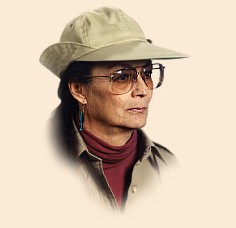|
Fly Anglers OnLine lost a supporter recently. It is always
hard to say goodbye to those we care about, even harder when
the loss is unexpected. Jim Chapralis found us in 2002 when
he was looking for places to publicize his first book,
Fishing Passion. He became hooked, and stayed.
Jim provided FAOL with a wonderfully informative section on
Casting including the rules for the various tournament events.
Jim's second book, Le Shack, was completed by his
wife Sally, when his health prevented him from finishing it.
Le Shack is delightful, watch for a review of it here soon.
This becomes a story within a story.
As Jim became involved again in tournament casting, this time in
the Senior division, he found himself exposed to the problems
facing the fishing world.
Once exposed, he became very involved and active in what is
perhaps the most serious - and least understood. Water. The
dangers in seeing prime headwaters sold to provide bottled water
to a thirsty yuppy population. What did they drink before
bottled water became 'in?'
The next time you are in your local supermarket, take a serious
look at the number of bottled waters available. Where does this
water come from? One of the battles Jim was involved in was
against Perrier. This particular fight was over the Mecan
Springs chain in central Wisconsin.
Perrier/Nestle eventually gave up on that one after they discovered the
locals would rather preserve their environment than give it
up for a few jobs.
Prior to the attempts for the Wisconsin water, Nestle
secretly negotiated with Michigan government to build a
bottling plant eight miles south of Big Rapids. The plant
was completed and in production in May of 2002. One year
later the plant was doubled in size. The bottled water
is marketed under the Ice Mountain label.
Quoting from Jim's book, "The impact on the economy? Nestle
received almost $10 million in incentives and school taxes
were waived for 12 years. Amazingly, only as few as 45
employees are needed to operate a modern bottling plant.
Again, since the water is free, it was estimated by experts
that Nestle could gross between $500,000 and $1.8 million
dollars a day. Repeat: A DAY!"
The money from the bottled water plants is incredible.
The good news is an injunction is in place and limits the
amount of water Nestle can pump there subject to further
tests and an Environmental Impact Statement.
Folks, these are just a couple examples of what can happen.
Supposedly Nestle has about 30 pumping locations in the
United States. The two examples I've shown do directly
affect watersheds of trout streams. No water - no fish.
Or so much water is extracted that it lowers stream levels,
warming the water beyond what fish can tolerate.
I do not understand the 'need' for bottled water. Our cities
and municipalities have excellent water treatment and
distribution plants, we do not need bottled water. Convenient
to carry with you? Fine, fill a water bottle and put it in
the frig until you're ready to leave. Then take it with you.
Probably tastes better anyway.
Removing water from the eco-system, selling it back to us
just doesn't seem right. And what happens when the water
runs out? That water should remain in the public trust,
and not for "obscene" profits.
As Jim stated so well in his book, "water will become as
important as oil is today. You don't need oil to survive
but you need water."
Keep your eyes open, this could be happening near you, right now. ~ The LadyFisher
If you would like to comment on this or any other article please feel free to
post your views on the FAOL Bulletin Board!
|

